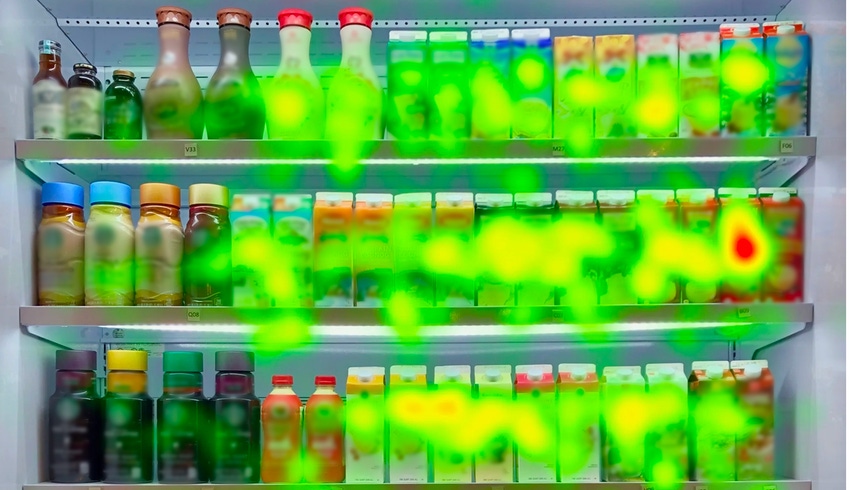A seasonal study of at-shelf decision-making on a dairy shelf yields four takeaways that are helpful for any packaging design.
February 23, 2023

Consumers savor the holiday spirit every winter with cartons of eggnog. But how do they choose from the wide variety of options they find in the dairy section? In a seasonal study demonstrating the power of packaging, Package InSight by Quad assessed the most important factors for decision-making at the shelf within the eggnog product category.
The company uses a strict methodology to equip marketers with the proprietary data they need to optimize return-on-invsetment on brand creative. Using the latest in biometric technology — such as mobile eye-tracking and facial coding — these studies analyze package performance, consumer attention, and shelf impact. The data these methods reveal offers brands crucial consumer behavior insights that can enhance their competitive edge in their respective categories.
For this study, Package InSight experts audited five national grocery stores and put all their national and store-brand eggnog to the test. The research aimed to highlight the power of packaging and show how design can influence customer behavior in the food and beverage space.
The study comprised both qualitative and quantitative aspects, including an eye-tracking experiment and a sensory taste test. The eye-tracking biometric glasses at Package InSight measure a person’s gaze to track their eye movements and attention span, revealing how long an individual looks at a package, how quickly they notice a package, and how often they look at a package. With this data, researchers can analyze the statistical differences in consumer behavior to discover which brands were deemed the most competitive on the shelf and what elements of their package design drew consumers’ attention.

Gaze Plots provide a moment-by-moment breakdown of the order in which an individual shopper reviews the options and how much time is spent looking at each one.
The results offer insights not just for eggnog brands, but also for food and beverage marketers at large that seek to make a product more competitive on the shelf with strategic packaging updates.
Here are the top four takeaways from the study that can offer brands insight into their own packaging design strategies:
1. Design can influence the product experience.
During the study’s sensory test, researchers found that the “organic” label on eggnog packaging had a significantly positive influence on participants’ experience of the product itself. Participants ranked eggnogs with an “organic” label higher for taste when they saw the brand packaging versus when they blindly tasted the product. The use of the term “organic” in the brand’s packaging design influenced the actual sensory experience of consumers.
To bring this enhanced experience to a brand’s consumers, marketers should be on the lookout for trends in key words within their product space and experiment with incorporating strategic language and visuals—such as the term “organic”—into package design.
2. Lean into product appeal and other consumer preferences.
Focus group participants demonstrated a strong preference for packaging that featured health-related tags including organic, low-fat, and all-natural.
With the evolution of diet culture and an increase in food sensitivities, labeling dietary preferences and needs as differentiators prompts consumer choice. Brands that include clear labels on product packaging to highlight special dietary features will help more of the right consumers find them.
3. Never underestimate the value of sentiment.
The historical origins of eggnog can be traced back to the Medieval era. It has been recognized as a festive holiday drink since the American Revolution. For many consumers, the annual consumption of eggnog during the holiday season sparks feelings of joy and nostalgia. Thus, it may be no surprise that the top-performing tag for eggnogs in the study was the word “traditional.” This signals yet another consideration for marketers: The sentiment factor.
As traditions and traditional values are widely embraced during the holiday season, it is understandable that participants would desire a traditional eggnog brand for a traditional festive drink. Capturing the sentiments consumers associate with a particular product space can be an influential tool in packaging strategy.
4. Don’t depend on brand loyalty to win the day.
Success is never owned. It’s rented, and the rent is due every day. -- Rory Vaden
Today, brand loyalty is not guaranteed, and consumers increasingly make their decisions while they browse the shelves. Findings from Package InSight’s eggnog study showed that consumers expressed low brand loyalty and a preference for store brands due to their lower prices and the product’s seasonal nature. Brands that recognize how more variety on the shelf has increased both market competition and the power of the consumer — and use data to adjust their packaging accordingly — will win the day.
From leveraging health trends to tapping into personal sentiment, this study in eggnog brands demonstrates the power of packaging to drive consumer choice at the shelf. While adding the term “traditional” may not be the answer for every brand, marketers in any product category can benefit from strategic use of key words and design elements that resonate for the category. With insights from focus groups and store environment competitive analysis, along with biometric data, brands can always sweeten their packaging shelf appeal.
Felty unpacked the science of biometrics late last year in Biometrics: Seeing Packaging Design Through Consumers Eyes, published November 2022.
Drew Felty is co-founder of Package InSight by Quad, a consumer research lab in Greenville, SC, where brands make data-driven packaging decisions that drive adoption and sales. Felty has applied two decades of entrepreneurial experience to develop bottom-up research methodologies to see packaging through consumer eyes and to change the way packaging is researched, designed, and produced. Drew is also co-founder of PackagingSchool.com.
Numbers =
About the Author(s)
You May Also Like




